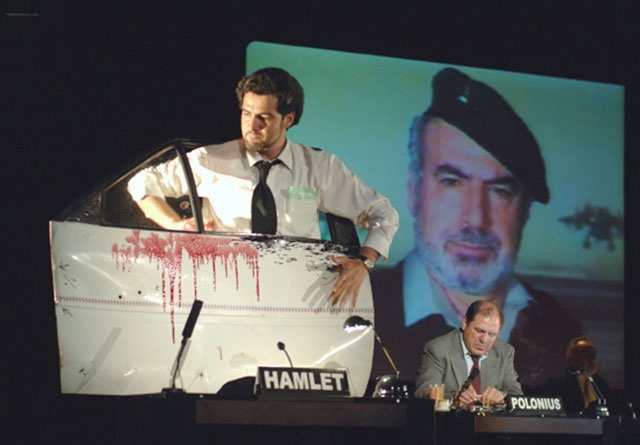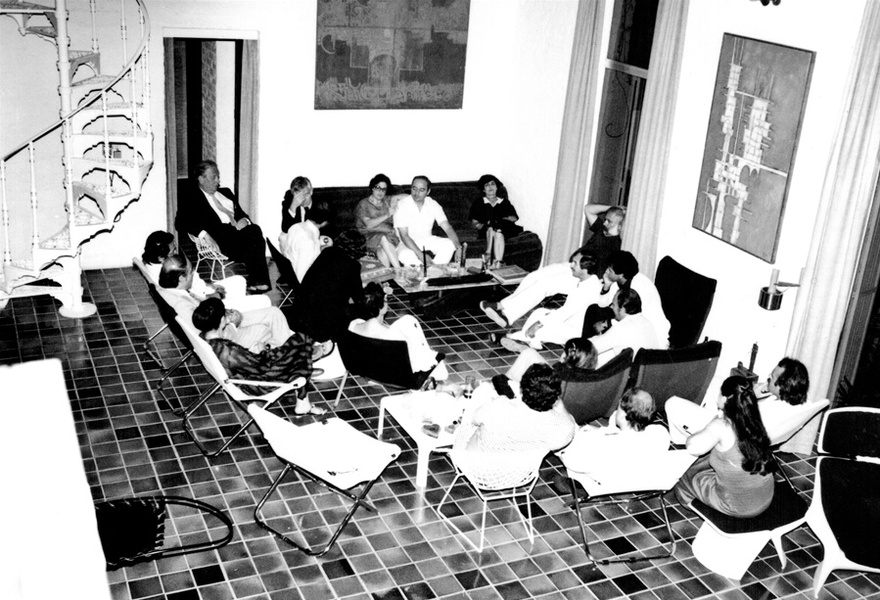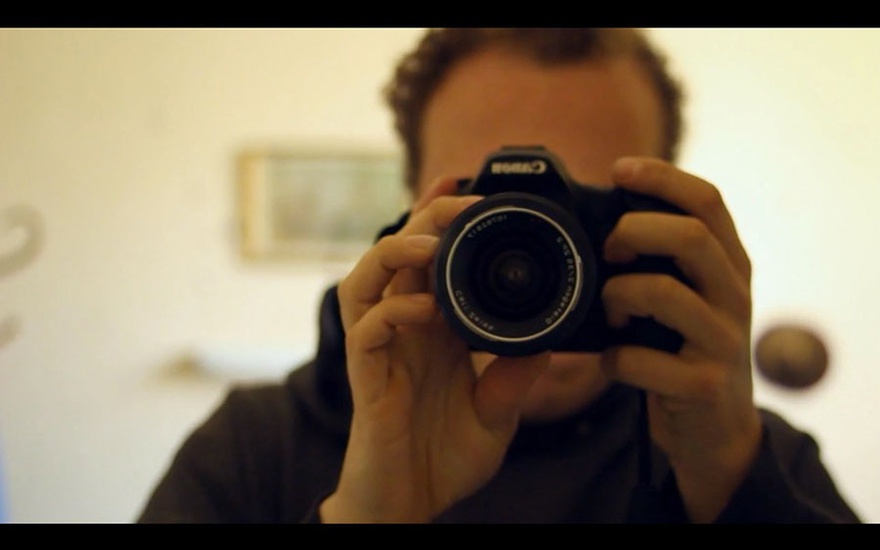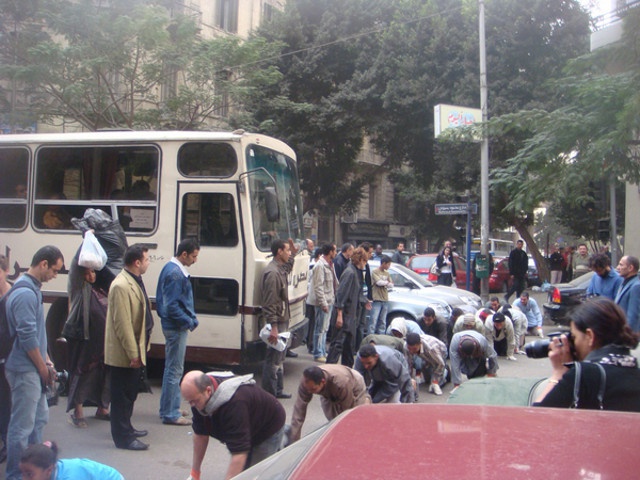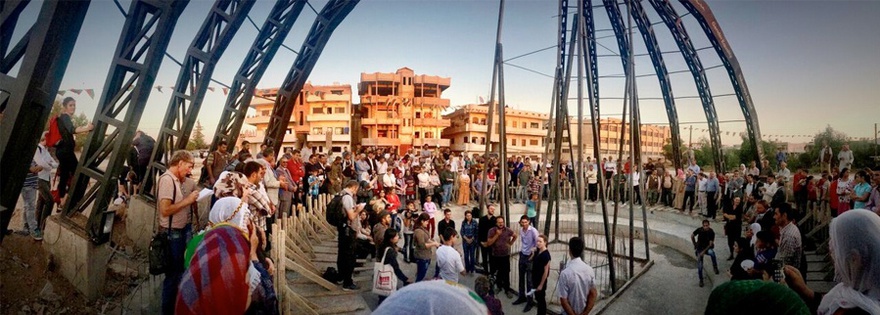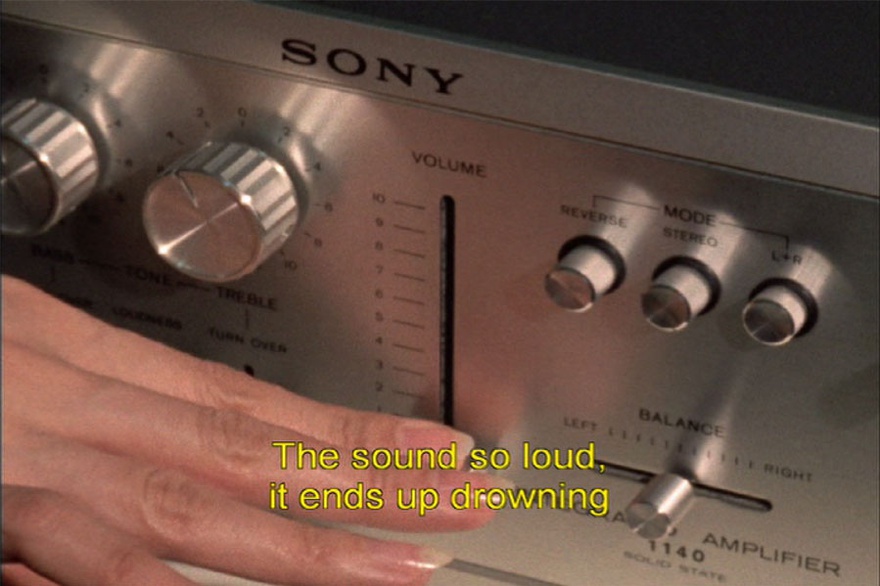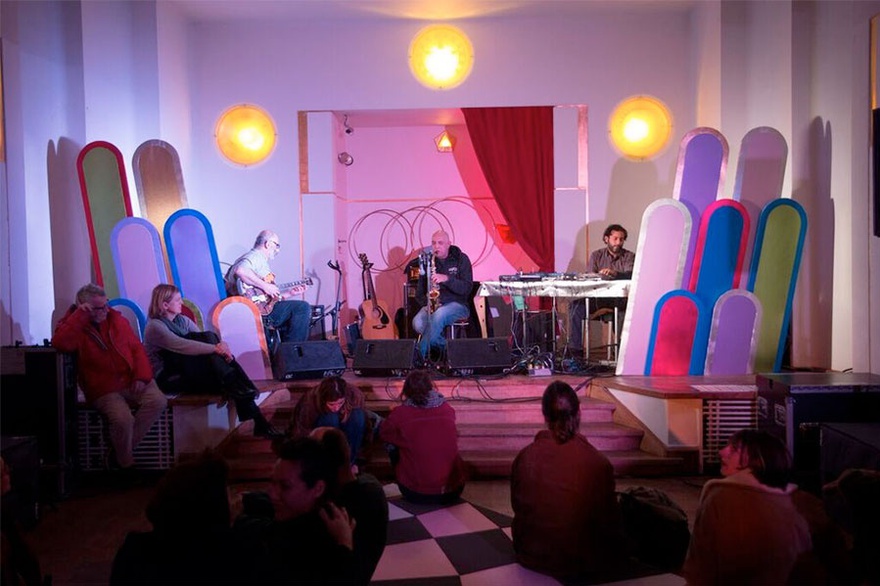Essays
Violent Relatedness, Embeddings, Hindsight
[T]his is us, we who are supposed to say we as if we know what we are saying and who we are talking about.
– Jean-Luc Nancy[1]
I favour to look at archives non-chronologically, partly because of impatience and un-imagination, but mainly because I do not want archives/collections to be didactic through the logic of relatedness; that they enforce a logic to how or what to read in them. I might later realize I misinterpreted an archive's motives, and though I feel horrible, I am protected by the space of fiction allowed by my practice as an artist. Such a space of permission is the imagined scenario of an alternative relation between incidents, adopting or adapting a skill from existing modalities that surfaced or was absent from accumulated collections/archives. In an artistic practice, what choices are available to us individuals when a violent relatedness delivers (us to) the world, its news, the crises of others, and our in(st)abilities? How does the use of the 'I'and the 'We' shift as representation? In what descriptions of these practices lies the knowledge that needs articulation and reproduction?
This text is a revisit to relatedness and an edit on what is embedded within it – of permissible methodologies, hesitations, and representations – as found mostly in materials published on Ibraaz's Platform 010, published between May 2016 and April 2017, under the question: 'where to now'? It is an attempt at reading creative production from the angle of its relationship with the community, specially to where and why creative practitioners referred to themselves as individuals and when and what they referred to themselves as part of a community.
The first part looks into the degrees of relatedness that individuals assume in the process of producing artworks, and in retrospect in receiving them. I will look at contributions to Platform 010 that appear to (re)present a general body, government, or persona, but do so knowing that this appearance is a mere facilitator of access to the subjects the artists were interested in investigating, critiquing or enjoining. It also notes the shifts in how the body and the exclusivity of the collective are discussed when individuals describe a relatedness to an overpowering national pattern, event, or limit.
The second part looks into examples of inserting (foreign) individuals into pre-defined collectives. The readings are marked by the trembling times of political change driven by a revolutionary impulse, in which a number of questions arise. What are the boundaries for the collective, beyond the national, language and geographic that allow individuals to insert themselves in these incubations? In whose eyes are these classifications (or divisions) made? And when an artist practice, or artwork, is dependent on the performance of the collective, what part of the work is the collective labour of the group and which part is that of the artist?
Embeddings
In his essay 'Staging the Nation', Barrak Alzaid writes about Sulayman Al Bassam's decision to mask his 'radical' work behind the 'classic literary status' of Shakespeare.[2] Alzaid quotes Graham Holderness, who quotes Al Bassam: 'In addition to being rich, malleable and volatile material, Shakespeare guaranteed me my "green card" past the Cyclops of the state censor and the prejudices of a largely conservative society'.[3]
In his essay 'From Summit to Tragedy: Sulayman Al-Bassam's Richard III and Political Theatre', Holderness describes Al Bassam's choice as a 'Trojan Horse' – 'a cultural monument that enabled him to smuggle critical views on his own society past the authorities'.[4] Alzaid related this to an excerpt from a Kuwait Towers' brochure illustrating a 'practicality' that justifies the state investment in an architectural monument. The towers commemorate the water distribution network; an infrastructural feat of the young state around 1976. The monument's appearance, a globe and rocket, is described by its Swedish architect, Sune Lindström, as a 'reference to the Islamic past through the minaret-like quality of the shafts and through the multi-coloured mosaic-like facing of the globes, recalling the tiled domes of historic mosques and shrines'.[5] Al Bassam and Lindström used the status Shakespeare and Islamic minarets (both are general, famous and point to no particular persona) as referrals for works with embedded functions, as they presented them to another general entity: be it the government or the public.
In his conversation with Amin Alsaden and Balkis Sharara, architect Rifat Chadirji speaks about the methodologies that allowed him to capture thousands of photographs of several sites in Iraq, in the years when photography of public spaces was not tolerated by his government(s). In his interview, Chadirji talks about how he juggled one 'governmental' permit to enable another: first he got a permit from the Mayoralty of Baghdad, and once he had that he went to the Ministry of Interior, where he received another. 'With these two in hand,' Chadirji notes, 'I went to the Department of Religious Endowments, and they immediately gave me a third one. Once I had these three permits, I headed to the Ministry of Defence, and got their approval'.[6] He believes his name allowed this access: 'Do not forget that my name often facilitated my mission: it was clear that I was not a spy, but a keen young man interested in photography.'[7] Chadirji was aware of the precarity of his 'credibility', because not only did it allow him access, but also limited it – particularly when local authorities suspected he was a communist upon his return to Baghdad from his studies in England in 1952. 'I was imprisoned briefly based on false claims […] and I was released. When I took photographs, it was known that I was not involved with politics – that I was neutral.'[8]
Chadirji refers to neutrality as a safe zone for production, and for allowing a documentary practice like his photographic collections to exist. He notes another safe zone implied by the way he looks and speaks, where interruptions to both – his and the observed/involved subjects – were at minimum: 'When people saw me relaxed, taking photographs without fear, they left me alone. They wondered whom I might be, thinking I was some foreigner brought in by the government. It helped a lot that, to the people on the street, I looked like a foreigner. […] It was amusing to hear people talk about me, in my presence, thinking that I did not understand Arabic.'[9] To locals, a foreigner allowed access rendered Chadirji a representative of the government. But as an individual, Chadirji represented many institutions including his own, Iraq Consult and Chadirji Foundation, as well as the Iraqi Government, oscillating between negative and positive poles throughout his career.[10] On the Chadirji Foundation website, the mission confirms that Chadirji's efforts are those of an individual who wanted 'to promote intelligent architecture in the Middle East which is architecture concerned with healthy social relations and which encourages an affinity between the individual architect and the public.'[11]
One thing to highlight about the precarity of Chadriji's work as an individual; he was working in the top administration of Baghdad's Mayoralty in 1982 when he had to rush to capture the Monument to the Unknown Soldier being destroyed upon Saddam Hussein's orders. In a photograph he included in his monograph, Al Ukhaider and the Crystal Palace, he is seen standing next to the rubble and the employee who operated the bulldozers. Their faces reveal nothing about the ruins that sit behind them. In the interview, as we understand that Chadirji has thousands of photographs, his wife Balkis Sharara comments: 'We never saw these photographs, partly because Rifat kept them at his office. He would just develop the films and print contact sheets, and keep collecting them at the office. […]. I saw the whole collection for the first time when we moved to London'.[12] Chadirji made a decision to distinguish his 'artistic photography', labelled on his website to be his photographs taken between 1976 and 1978 and 1980 and 1981, from his photographs from 1950 to 1980 that he labels 'social photography'.
At one point in the conversation, Alsaden asks Chadirji: 'you also captured another reality: that of your own class and social circles. We saw numerous films of parties at yours and your friends' houses. Beach outings, musical concerts, "dishdasheh" and costume parties, boat trips, and endless dinners.'[13]
Chadirji responds: 'That was the reality of our group. There was no pretension in our lives. […] These were the people with whom we had an affinity. They were physicians, historians, university professors; generally intellectuals.'[14]
Sharara explains further: 'Our friends looked at the world differently. They were well educated, well travelled, and most had studied abroad. They were aware of what was going on in the world even if they had not travelled.' [15]
Alsaden asks again: 'The difference between your social group and your spaces, and that of the other people you photographed, rather startling. Was that the nature of Iraqi society, these extreme polarities?'[16]
Sharara answers: 'There was hardly anything in between. The middle class was very weak, which is why we had a revolution.' [17]
The revolution mentioned by Ms Sharara is a reference to the events of 1958, which overthrew the monarchy, when Chadirji was brought closer to the 'development' administration of the new republic, and was commissioned to design the Monument to the Unknown Soldier. While Chadirji talks about recycling a ready sketch from before 1958 for this monument upon his quick summon to the new republic's prime minister's office – in other words how an artistic design could serve two opposite political conditions – it is worth studying what body his wife refers to when she says 'we had a revolution'. Here she does not speak in the name of the individual, elite, and government-related individual, but in the singularity of a 'revolting' nation.
The nation, the government, foreigners, and Shakespeare, are general collectives. They do not institute a threatening position, and relating to them seems to be a norm of some sort. The position of the creative work to be produced within this frame cannot be anticipated or grasped in advance. The afterlife of Al Bassam's critical work (that is shown upfront) or the neutrality of Chadirji's documentary work (that hides for a while before opening up) shares a similar precarity; they both are prone to discontinuity from the moment they reveal their real relatedness, at the moment the work is shown. They confess, or exploit, the 'generalities' behind which they hid, as they produced their work, and manifested their personas. Ms Sharara's last comment is a reverse of this transformation, even if temporarily; she does not speak in name of the elite/exclusive/identified persona, but in the name of a wholesome nation.
Violent Relatedness
I must stress that it's my eyes that saw what I thought I was describing, and my ears that heard it. The form I adopted from the beginning for this account was never designed to tell the reader what the Palestinian revolution was really like […] All these words to say, this is my Palestinian revolution, told in my chosen order. As well as mine there is the other, probably many others.[18]
The following section is on what other inclusivities might be traced in texts and artworks produced during and after a revolution presented as part of Platform 010. It focuses on Louis Henderson's conversation and online presentation of the documentary film Logical Revolts, for which Hendersontakes the expressions of previous foreigners as a guide towards approaching a trip to film Egypt post-2011 revolution. He carries an annotated script of a UN film on Suez crisis (1956) in one hand, and Jean Genet's Un Captif Amoureux (A Prisoner of Love, 1986) in the other. On Un Captif Amoureux, Henderson notes in conversation with Amira Gad: 'This book greatly informed the development of the narrative of the film during the editing and writing stage – both in terms of Genet's insistence on the personal reading and "failed" representation of a situation in which he was always a white European outsider trying to look in on something that escaped him culturally.'[19]
Aware of and wanting to relate current events to complicated colonial legacies in his approach to the Egyptian revolution, Henderson's documentary plays with and bends 'the plasticity of the real', in 'a way to self-reflexively and critically challenge the role and the potential fallibility of the first person narrator in the telling of colonial histories.'[20] He offers the viewers the position to critically read the artist who made this film, through proposing the film as 'an allegory based on the real', so it is be read through the artist himself and a documentation of a factual account.[21] The subject is continuously referenced in the film, as the artist assumes and performs a third-person role, narrating a text pretending to be read by another person. Henderson's early emails are quoted: 'Using the first person in cinema is a sign of humility. All I have to offer is myself'.[22]
***
In Stephanie Bailey's interview with Tarek Abou El Fetouh on The Time Is Out Of Joint, she describes a framework that 'replaces "region" with relation' and asks about the 'neutralization of the binary divisions between the so-called postcolonial and imperial nations of the world'. [23] Abou El Fetouh's project attempts to understand the 'I' and 'We' beyond normative terms or historical definitions of the world as is. He believes that the 'contemporary art world is one of the successful examples of cosmopolitanism', because of its porous body that shares a great, though non-inclusive, number of resources, exhibition spaces, and artists, who produce links between what they encounter of places, people, and archives. He discards the term 'Arab art', because he believes it is not important today which geography an individual comes from.[24]
In his multi-space project, disaster can relate one person/group to another, or the exclusions within Arab nationalist states (or Arab biennales back to their first in Baghdad in 1974) can be shocked by the inclusion of artists from the 'Far East' or by inducing an emotional rather than Arab state. Abou El Fetouh's argument looks beyond the geographical and national containers and quotes Judith Butler's argument, in her essay on Bodies in Alliance, on the space of equality created by the demonstrators in Tahrir Square in Cairo that transcended gender, class, and religion. To Butler and Abou El Fetouh, 'all the people in Tahrir were performers, because they knew they were being watched, and this performance made the space much bigger than the physical space of Tahrir Square itself, since it included people from other parts of the world who wanted to share the moment of performativity.'[25]
Bringing this back to Henderson, you might say that Tahrir Square invited Henderson to come to Cairo. It also did not tolerate the very means that it used to lure him as an individual to come down to join its revolutionary collective. The artist looks for the logic behind refusing his camera versus the abundance of local mobile phone images, and thus assumes that it is certainly because he is a foreigner that his place there was being questioned.[26] He relates this to the (post)colonial legacy that he continuously refers to in the film.
It is worth thinking about this polarity in assuming a relatedness to the revolutionary context that attracted Henderson; he is the narrator that tells the story of the filmmaker, who surfaces unexpectedly as a first person following moments that shock or redirect his filming intervention. In his film, the locals' disenchantment with people and their cameras 'problematizes where the "subject" is located'.[27] The artist voiceover speaks about 'Henderson' as a 'he' and 'I' sometimes in the same shot. 'He' becomes the state of intention that the artist arrived with in Cairo (armed with the books and films produced by fellow 'foreigners' on the region/subject/revolutions), and 'I' becomes the individual confronted by his relationship to the host collective. The people in the roundabout object, 'Tahrir Square is not a safari!',[28] but no one says anything when Henderson is in the other parts of the city.
As I was writing this article, I was constantly trying to recall a quote by Giorgio Agamben on singularity. On belonging to many things at the same time. On having an undefeatable position by simply not articulating a request. And on not defining a position, as it is the only thing that government knows how to capture. When non-expression becomes a stronger position that defeats powers, governments; something learned from a sit-in Tiananmen Square. In this respect, I return to Abou El Fetouh's preface for the publication for The Time is Out of Joint that we co-edited, where he relates the image of 'Tank Man' (1989) from Tiananmen Square to an image of an unarmed young man challenging a tank during the Egyptian revolution in 2011. He writes:
There are formal and contextual similarities between the two images', and how technology and social media offered a space greater than the 'squares'; and how 'The evolution of performativity produced new strategies, and inspired artists to think of possibilities that challenge the state's establishments, affect the change resistance of the middle classes, [and] conduct body metamorphoses.[29]
Permissions, allowed by the people on the street, reshape the artistic expression.
***
Shuruq Harb wrote on performance and derailed art projects in her analysis of Amal Kenawy's last performance, Silence of the Sheep. The performance was created and enacted across the streets of Cairo in 2009 using a group of people employed by Kenawy, in the context of an exhibition at Townhouse Gallery titled Assume the Position. Kenawy's performance caused controversy on the day it took place, with its documentation awarded on its showing at the Cairo Biennale the following year, taking on further symbolic meaning after the 25 January revolution in 2011. The controversy when it was enacted in 2009 arose when men from the street understood the performance to be humiliating for the performers, mainly men who were contracted upon the withdrawal of Kenawy's original team comprised of her own students. This resulted in a heated discussion between onlookers and Kenawy, who interrupted the work to engage in an unscripted quarrel that was not actually allowed in the rules created for the performance. Since these exchanges were caught on camera, they later became the core of the work.
On the performance, Harb wonders why Kenawy's students would withdraw on the day it was staged, why the artwork has been tolerated in the gallery but not on the street, and if the artist's gender affected the reception. It was only the potential of fiction that could have allowed for this work to pass, Harb argues:
There is a strong chance no one would have objected if the performance was part of a scene for a film. This would immediately imply that it is fiction, located within other fictional scenes that would render some legitimate meaning to what the public overwhelmingly perceived as a 'humiliating act'.[30]
Harb also argues that Kenawy was alienated from her performing group, because she walked rather than crawled with the other performers (an 'anomaly within her own performance'). When a member of the public interrupts Kenawy, saying 'who are you?' Kenawy responds, 'We are moving the artwork into the street!! […] So we are trying to connect our point of view to our community.' Kenawy insists on the collectivity of the act and intention of the expression by speaking in the 'we' and 'our', opening up the question to who is the collective in Kenawy's words. Like Sharara, she temporarily transcends the representation of the artist, and attempts to speak in the name of the collective. When a man from the public objects to this approach, as he is clearly able to single out the artist from the group, we see how both man and artist relate to the same 'we' but have opposing opinions on the limit to which one can go to represent it. He says, 'They told you that making people walk like animals is art?!', the artist responds on similar folk art that is 'about interaction with people walking in the street out of the traditional indoor art forms'. The artist refuses the self-imposed authority of the community, and invites the man to join the performance. Later, for her installation at the 12th Cairo Biennale, she added elements from her own domestic space, as Harb notes. Harb quotes Sarah Rifky, a curator who took part in the performance, on her frustration about the way the interruption that took place in 2009 when the work was performed turned the performance into a discussion 'around Amal' – ie. the artist herself. Kenawy is a local, she could look and speak like the people who are objecting to her performance. Unlike and like Henderson in her relationship to the collective, the street spectators' see the artists' ideas for capturing performativity of the collective impermissible. This violent reaction to the artists' ideas of relatedness becomes a constituent of their work.
***
In relation to treading the invisible borders of collectives, creative practices and oneself, Haytham El Wardany analyzes the first subject as a position of the recipient (reader), particularly as it lead to the imprisonment of the writer Ahmad Naji.[31] Naji was sued by one of his readers, for some of the content that appeared in his fictive novel. The reader reset the relationship with the creative work and stripped Naji of the protection offered by the space of fiction allowed by his creative practice. The reader, like Kenawy's intervener, saw that the 'I' in the creative work is not separate from the 'I' of the author. El Wardany asks how 'The question of who is this 'I' that is speaking, is a truly political question'.[32] He links to the question of which group this 'I' is speaking, and what is regulating the relationship between them. 'The legal "I" is the one that could be bureaucratically regulated and administered.'[33] He argues the mission of fiction in shaking the reality of authors having experienced what they wrote about. Particularly, as they write in the first person, what liability literature offers to authors as they write in the first subject. To link El Wardany to Kenawy and Henderson is not to look into if they want to defend freedom of speech, but in the way they 'test reality' as they scrutinize the 'I' under the lens of creative work.
Relatedness
'Compassion is not altruism, nor is it identification; it is the disturbance of violent relatedness.'[34]
In an interview with Younes Bouadi about his work with the New World Summit, Bouadi acknowledges 'the political and practical impact of what it means to work with individuals being labelled as a terrorist or as a member of a terrorist organization.'[35] He speaks of enabling a 'grey area' of negotiators and legal representatives who are 'able and willing to represent these organizations publicly.'[36] This has been an essential means to evade political implications that would affect not only the artist, but also restrict the travel of those identified as members of such groups. As part of the New World Summit, speakers from 'progressive and left-leaning ideologies' would meet as a collective of EU and US blacklisted organizations, with speakers, not listed as terrorists, presenting on behalf of organizations subjected to 'ongoing anti-terror legislation'.[37]
The result of these summits was a mixing of art and state-rejected groups, resulting in an invitation from the 'democratic self-administered' of Rojava, a territory in north of Syria, to Jonas Staal Studio to construct a parliament building. Among the questions the studio asked themselves was about the type of architecture they put together to represent this new experiment of a region/democracy, particularly when materials were redirected to destructed cities that severely needed reconstruction. His discussions of practicalities with the local engineers and architects assigned by the local city council to the project; contractors, materials, procurement processes, is his attempt to understand 'how Rojava operates.'[38] When the building was present(ed) during an international conference (that was in itself a complicated event due to the conflicted security of the region it is in) 'it wasn't complete, it was finished up to a point where we could hold the opening ceremony inside.'[39] Bouadi relates this to being aware of existing on the edge of a particular moment in history, and learning from the mechanisms by which the moment's 'new' institutions develop and maintain their structures.
This last example of artistic practice embeds itself in the processes of making a (new) community – a future 'we'. The artistic intervention is not only this process and the resulting built architectural structure, but also a mutual agreement on relatedness; to be inside and outside this community collective at the same time. The artists are brought in to think, build and leave a national structure that will represent 1) the adolescence state of this community, and 2) the artistic intervention; and (perhaps) not the artists themselves.
Hindsight
For Platform 010, Zeynep Oz asks Fadi Bardawil on the 'interdependencies', 'contradictions' and 'symbiosis' in the relationships the artists have with the resistance movements in 1960s. Bardawil does not see it a 'uniformity of positions' but rather 'an intense circulation, negotiation, and transfiguration of theories, aesthetic forms, and modalities of political practice'.[40] His analysis of projects produced by artists who stood in solidarity with other causes, is based on the artists re-visitation of their own interventions. 'We did what many others were doing. We made images and we turned the volume up too high', he quotes a voice over from a Godard film: 'The sound [was] so loud that it ended up drowning out the voice that it wanted to get out of the image.'[41] For Bardawil, to look into the past answers is only a way to deconstruct the politics of 'exclusion' and arrive at a 'common, interconnected world.'[42]
In a review of a performance by the 'Dwarves of East Agouza', a musical trio from Cairo, staged as part of Meeting Points 8 in Brussels curated by Malak Helmy and Raimundas Malasaukas, Laura Cugusi notes the 'non-verbal codes of communication (nods, body movements, glances), which made it possible to direct, divert and link different melodic and rhythmic flows without hesitation, adjustment or abrupt shifts of chords and progressions'.[43] She describes the space of communication among these musicians as 'an intimacy and collective sensibility that is impossible to speed up or replicate', similar to other artworks in the project that collectively resist the urgency of relevance or by 'inhabiting the space without discursive shortcuts or a clear set of expectations.'[44]
Cugusi's reading of the bond between members of the collective made me think about the modes of collaboration described in the other examples I picked up earlier in this text. The impossibility of this comparison is what inspires my link. Dwarves of East Agouza enjoy this coherence because they chose to form a collective, have rehearsed to perform its coherence to the public, and kept a clear divide between their collective as performers and the audience. Their 'I' is defined as a staged 'we', and this 'we' is not pretending to include the others that are in the space of performativity. They are in one way similar to Al Bassam's proposals for staging performance, albeit without the critique for the watching audience; neutral as Chadirji interventions seemed to be, and perhaps do not have a community embedded as part of their own work like Henderson and Kenawy.
Similar codes appear in Khalid Abdalla's story, where the gesture of 'swimming backwards' was his and family's collective means of returning to shore after failing to feel any progress in their swimming forwards. Each swimmer counting a hundred strokes before looking towards the shore in order to see if they were moving, it was by the fourth hundred stroke that 'each believed that maybe we had moved',[45] he writes. 'And then one by one over the next few hundreds we turned back and swam forwards increasingly certain that yes, we were nearing the shore and that perhaps that had always been the case, it's just that when we were so far out each shift seemed invisible.'[46] What united the group is their attempt to survive through a code that agreed on for their individual work. No state, no audience, no derailing forces but that of nature shaped their performance. And there was no place to be outside this collective.
***
In Platform 010, belonging and relatedness have been practically true when it was a matter of convenience – that is, when it came to thinking about where to go from the here and now. While the fictive space of literature allowed a national critique (Al Bassam's hideout in iconic figures we), it implicated another author (Naji's explicit description of personal experiences, I). The neutrality of a local who looked like a foreigner (Chadirji pretending to be we) allowed him access to capture images of a collective that he was aware he was majorly different from. Neutrality is contested in the age of heavy image reporting on political events (Henderson's I, Butler's theory on the performative we). A violentrelatedness (Abou El Fetouh's belief in artists-contexts incubations, we) is itself disrupted by collective defeat, or by members of society who do not agree with certain artistic gestures as it reflects on this failure (Kenawy's render of the society submission, we). Gestures appear to be another space of forging a collective – take the synchronization of each the musician's 'I' in a trio, and Abdalla's swimming we.
[1] Jean-Luc Nancy. Being Singular Plural. Translated by Rober D. Richardson and Anne E. O'Byrne. Stanford, CA: Standford University Press, 2000, xiii.
[2] Barrak Alzaid, Staging the Nation, Ibraaz 010_00 / 6 May 2016, http://www.ibraaz.org/essays/149
[3] Ibid.
[4] Graham Holderness, 'From Summit to Tragedy: Sulayman Al-Bassam's Richard III and Political Theatre', Critical Survey 19, no. 3 (2007), accessed February 27, 2017, doi:10.3167/cs.2007.190307, http://uhra.herts.ac.uk/bitstream/handle/2299/1732/901915.pdf
[6] Amin Alsaden, Capturing Evanescence Rifat Chadirji and Balkis Sharara in conversation with Amin Alsaden, Ibraaz, 010_06 / 16 November 2016, http://www.ibraaz.org/interviews/206
[7] Ibid.
[8] Ibid.
[9] Ibid.
[10] Including when he travelled to meet Le Corbusier in Paris following the political events of 1958. He wanted to apologize for the government's delay in paying the fees related to a sports complex he was commissioned to design for Baghdad. Le Corbusier passed away (in 1965) unpaid, and his foundation and Chadirji continued to follow up on this matter. These efforts are mentioned in a letter sent by Iraqi lawyer to the architect's contractor in November 1973, where he also mentions a court certificate on 'bodily heirs' was necessary for the Iraqi government to remit the late architect's pending fees. It read, "If Mr. Le Corbusier had died without any bodily heir and there were no competent evidence proving the existence of such heirs, is this case the Iraqi Government shall be the sole heir and, subsequently, possess the amount of the deceased." By law, the Iraqi government would be the representative of the late architect, if he had no brothers, uncles or relatives recognized by another government. Le Corbusier's sports complex commission shrank to a gymnasium that will be completed in 1980. Built in close proximity to the stadium, the Gymnasium takes several names, one of which is "Qa'et Al Shaab lil Al'ab Al Riyadiyyeh" [The People's Sports Hall], it was also called "The Saddam Hussein Gymnasium" before it became "The Baghdad Gymnasium". The gymnasium is representative of the people or the state, its public sports facilities, the ruling regime, and of the other architectural monuments that it lays close to. It is also representative of remains of my architectural training (that featured Le Corbusier and Chadirji) that came in the aftermath of the gulf war, strong presence of modern Iraqi art reshaping an art scene in Amman, and a proxy attachment/relatedness to a city that was losing its architecture to destruction.
[11] Amin Alsaden, Capturing Evanescence Rifat Chadirji and Balkis Sharara in conversation with Amin Alsaden, Ibraaz, 010_06 / 16 November 2016, http://www.ibraaz.org/interviews/206
[12] Ibid.
[13] Ibid.
[14] Ibid.
[15] Ibid.
[16] Ibid.
[17] Ibid.
[18] Amira Gad, On Logical Revolts Louis Henderson in conversation with Amira Gad, Ibraaz 010_02 / 6 June 2016, http://www.ibraaz.org/interviews/189
[19] Ibid.
[20] Ibid.
[21] Ibid.
[22] Ibid.
[23] Stephanie Bailey, The Time is Out of Joint, Tarek Abou El Fetouh in conversation with Stephanie Bailey, Ibraaz, 010_00 / 6 May 2016, http://www.ibraaz.org/interviews/193
[24] Ibid.
[25] Ibid.
[26] Louis Henderson, Logical Revolts, Ibraaz Channel, 010_00 / 6 May 2016. http://www.ibraaz.org/channel/108
[27] William Raban on Logical Revolts, by Louis Henderson, published on Ibraaz Channel, 010_00 / 6 May 2016. http://www.ibraaz.org/channel/108
[28] Ibid.
[29] Stephanie Bailey, The Time is Out of Joint, Tarek Abou El Fetouh in conversation with Stephanie Bailey, Ibraaz, 010_00 / 6 May 2016, http://www.ibraaz.org/interviews/193
[30] Shuruq Harb, Not so Silent On Walking and Crawling, Shuruq Harb, Ibraaz, 009 / 27 April 2016, http://www.ibraaz.org/essays/148
[31] A local reader filed a suit against Naji in Cairo in 2015, for explicit content that appeared in his fiction novel "The Use of Life". Naji was imprisoned for a total of two years.
[32] Haytham El Wardany, The Case of Ahmed Naji: The First-person and Politics of Literature, Mada Masr, August 2016. Translated from Arabic by author. https://goo.gl/v6dsai
[33] Ibid.
[34] Jean-Luc Nancy, Being Singular Plural, xiii
[35] Stephanie Bailey, Politics in Practice Younes: Bouadi in conversation with Stephanie Bailey, Ibraaz, 010_06 / 26 November 2016, http://www.ibraaz.org/interviews/207
[36] Ibid.
[37] Ibid.
[38] Ibid.
[39] Ibid.
[40] Zeynep Oz, Revisiting Internationalists Fadi Bardawil in conversation with Zeynep Oz, Ibraaz 010_03 / 10 July 2016, http://www.ibraaz.org/interviews/197
[41] Ibid.
[42] Ibid.
[43] Laura Cugusi, Both Sides of the Curtain Meeting Points 8, Ibraaz 010_08 / 15 February 2017, http://www.ibraaz.org/reviews/126
[44] Ibid.
[45] Khalid Abdalla, Swimming Backwards, Ibraaz, 010_05 / 31 October 2016, http://www.ibraaz.org/essays/167

